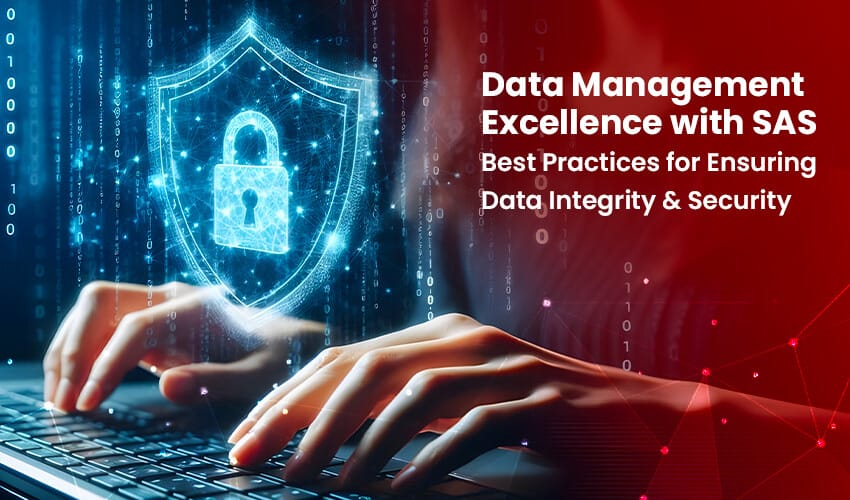Ensuring Business Continuity: The Imperative of Data Security Management

Driven world, data security is no longer just an IT concern, it is a fundamental necessity for business continuity. Organizations rely heavily on data to operate efficiently, make informed decisions, and maintain customer trust. However, with the increasing prevalence of cyber threats, data breaches, and system failures, businesses face significant risks that can disrupt operations and lead to financial and reputational losses.
Data security management plays a crucial role in mitigating these risks by implementing robust protection strategies, access controls, and recovery plans. A well-structured data security framework not only safeguards sensitive information but also ensures that business processes continue seamlessly in the face of potential threats. From cyberattacks and human errors to natural disasters, organizations must be prepared to handle unforeseen disruptions and maintain operational resilience.
What is Data Security Management?

Data Security Management (DSM) is integral to any organization’s strategy. It not only focuses on protecting data assets from the risks of cyberattacks but also ensures that data is handled in compliance with applicable legal and regulatory frameworks. It plays a critical role in the overall governance structure, bridging the gap between cybersecurity measures and business operations to enable secure yet flexible data handling.
- Data Identification and Classification: Identifying what data exists within the organization and classifying it based on its sensitivity and the level of security required. This step is crucial for prioritizing security measures and allocating resources effectively.
- Preventive Security Measures: Implementing encryption, intrusion detection systems, firewalls, and anti-virus software to prevent unauthorized data access and breaches.
- Detection and Response: Monitor data and systems for irregular activities and have a strong incident response plan in place that can quickly address any data breaches or security incidents. This involves regular audits and real-time monitoring to detect threats as they emerge.
- Recovery and Continuity Planning: Developing disaster recovery and business continuity plans that allow the organization to maintain or quickly resume mission-critical functions following a data breach or other disruptions.
- Policy Development and Implementation: Crafting clear and enforceable policies and procedures that govern how data is handled within the organization. This includes guidelines for data usage, security, access, and the roles and responsibilities of those accessing the data.
- Training and Awareness: Educating employees about data security risks and the importance of following security policies and procedures. Regular training ensures that all personnel know the latest threats and how to manage and protect sensitive information appropriately.
The Importance of Data Security in Business Continuity
Data security in Business Continuity is a critical pillar of business continuity, ensuring that an organization can operate smoothly without disruptions caused by cyber threats, system failures, or data loss. Without effective data security measures, businesses risk financial losses, legal penalties, and reputational damage. A breach in security can result in the exposure of sensitive information, leading to regulatory non-compliance and loss of customer trust. By implementing strong data security practices such as encryption, access control, and backup strategies businesses can protect their valuable assets and maintain seamless operations even in the face of unforeseen challenges. Ensuring data integrity and availability enables organizations to recover quickly from incidents and sustain long-term stability in an increasingly digital and risk-prone environment.
Key Threats to Data Security
Cyber Attacks and Hacking: Cybercriminals constantly develop sophisticated hacking techniques to infiltrate business networks, steal sensitive information, and disrupt operations. Phishing attacks, ransomware, and malware can compromise data security, leading to financial and reputational harm.
Data Breaches and Leakage: Unauthorized access or accidental exposure of confidential data can lead to serious consequences, including identity theft, financial fraud, and loss of intellectual property. Data breaches often occur due to weak security measures, unpatched software, or employee negligence.
Natural Disasters and Physical Damage: Events like earthquakes, floods, fires, or power outages can physically damage data centers and IT infrastructure, causing data loss or prolonged downtime. Businesses must have disaster recovery plans, including offsite backups and cloud storage, to mitigate such risks.
Insider Threats and Human Errors: Employees, whether malicious or negligent, can pose significant risks to data security. Misconfigured security settings, accidental deletion of files, or intentional data theft can lead to severe breaches. Organizations must enforce strict access controls and conduct regular security training to minimize human-related threats.
System Failures and Downtime: Hardware malfunctions, software glitches, or network failures can lead to significant disruptions in business operations. Without proper backup and recovery strategies, businesses may suffer data loss, service outages, and productivity decline. Regular system maintenance and robust failover mechanisms are essential to prevent such failures.
Core Components of Data Security Management
Effective data security management is built upon several key components that help protect an organization’s critical assets while business continuity. Risk assessment and threat analysis serve as the foundation, enabling businesses to identify potential security risks and vulnerabilities before they escalate into major threats. Data encryption and protection strategies ensure that sensitive information remains secure, even if unauthorized individuals gain access to the system. Implementing access control and authentication measures, such as multi-factor authentication and role-based access permissions, minimizes the risk of unauthorized data exposure.
Backup and disaster recovery planning is essential to mitigate the impact of data loss caused by cyberattacks, system failures, or natural disasters ensuring that businesses can quickly restore operations. Lastly, organizations must adhere to regulatory compliance and legal considerations, such as GDPR, HIPAA, or ISO standards, to protect customer data, avoid legal penalties, and maintain industry credibility. By integrating these core components into their data security strategy, businesses can effectively safeguard their operations against evolving threats and ensure long-term resilience.
Best Practices for Ensuring Data Security

To safeguard business operations and maintain data integrity, organizations must follow best practices for data security management. Implementing strong cybersecurity policies is the first step, ensuring that clear guidelines are in place for data handling, access control, and threat mitigation. Conducting regular security audits and assessments helps identify vulnerabilities and allows businesses to update security protocols accordingly.
Human error remains a major security risk, employee training and awareness programs play a crucial role in educating staff on recognizing phishing attempts, using strong passwords, and following security protocols. With the growing reliance on digital storage, utilizing cloud security solutions offers an added layer of protection, including encrypted storage, multi-factor authentication, and real-time threat monitoring. Finally, establishing an incident response plan ensures that businesses can quickly react to security breaches, minimizing downtime and financial losses. By following these best practices, organizations can create a resilient data security framework that protects against evolving cyber threats while maintaining business continuity.
Challenges in Data Security Management
Despite the importance of data security, businesses face several challenges in effectively managing and maintaining it. The evolving cyber threat landscape presents a constant challenge, as cybercriminals continuously develop new attack methods, such as ransomware, phishing, and AI-powered hacking techniques. Organizations must stay ahead with proactive security measures, but this requires substantial investment. Cost and resource constraints can limit a business’s ability to implement advanced security solutions, hire skilled cybersecurity professionals, or conduct regular security assessments.
The complexity of compliance requirements adds another layer of difficulty, as businesses must navigate various regulations like GDPR, HIPAA, or PCI-DSS, each with stringent data protection guidelines. Meeting these legal obligations demands careful planning and continuous monitoring. organizations must find a way to balance security with usability, overly strict security measures can hinder productivity, while lax security increases vulnerability to attacks. Businesses must develop a strategy that maintains strong protection without disrupting operational efficiency. Addressing these challenges requires a combination of technology, strategic planning, and ongoing education to ensure a secure and resilient business environment.
Future Trends in Data Security and Business Continuity

As cyber threats continue to evolve, businesses must stay ahead by adopting emerging technologies and strategies to strengthen data security and ensure business continuity. One of the most significant upcoming shifts is the rise of quantum computing and its impact on encryption, which could potentially break traditional encryption methods, pushing organizations to adopt quantum-resistant cryptographic techniques.
The increased adoption of Zero Trust Architecture (ZTA) is becoming a fundamental security strategy, where no user or system is automatically trusted, and access is continuously verified. This approach minimizes the risk of insider threats and unauthorized access. The role of AI in predictive cybersecurity is also expanding, as machine learning algorithms are now capable of detecting and mitigating cyber threats in real time, allowing businesses to respond proactively to potential attacks.
The growing importance of data privacy regulations continues to shape the future of security management, with stricter global laws requiring businesses to enhance their data protection measures to maintain compliance and avoid legal consequences. By embracing these trends, organizations can build a more secure, resilient, and future-ready data security framework, ensuring the continuity of their operations in an increasingly digital world.
Frequently Asked Question
Why is data security crucial for business continuity?
Data security is essential for business continuity because it ensures the protection, availability, and integrity of critical information. Cyber threats, data breaches, or system failures can disrupt operations, cause financial losses, and damage a company’s reputation. By implementing robust security measures, businesses can prevent data loss, recover from cyber incidents, and maintain seamless operations.
What are the biggest threats to data security that can impact business continuity?
The most common threats include cyberattacks (such as hacking, phishing, and ransomware), data breaches, natural disasters, insider threats, and system failures. Each of these risks can lead to data loss, operational downtime, and legal consequences, making it essential for businesses to have a strong data security framework in place.
How can businesses ensure data security to support continuity planning?
Businesses should adopt a multi-layered security approach that includes risk assessment, data encryption, access control, regular backups, and compliance with industry regulations. Additionally, having an incident response plan and training employees on cybersecurity best practices helps in minimizing security risks.
What role does technology play in modern data security management?
Technology plays a critical role in enhancing data security through tools such as AI-driven threat detection, blockchain for data integrity, cloud security solutions, and Zero Trust security frameworks. These technologies help organizations proactively identify vulnerabilities, mitigate cyber threats, and ensure the continuous availability of data.
What are the future trends in data security that businesses should prepare for?
Future trends include quantum-resistant encryption to counter the impact of quantum computing, increased adoption of Zero Trust security models, AI-powered cybersecurity for predictive threat analysis, and stricter data privacy regulations worldwide. Staying ahead of these trends will help businesses protect their data and maintain continuity in an evolving digital landscape.
Conclusion
Data Security Management is a necessity and a strategic advantage in the modern business landscape. Organizations can protect themselves from significant risks by prioritizing robust security measures and building trust with their customers and stakeholders. As cyber threats evolve, so should your strategies, ensuring that your data your most valuable asset remains secure against all odds.
Implementing a comprehensive DSM strategy is crucial for any business aiming to thrive in an increasingly digital world. Start fortifying your data security today to safeguard your tomorrow.






